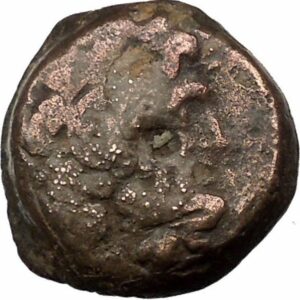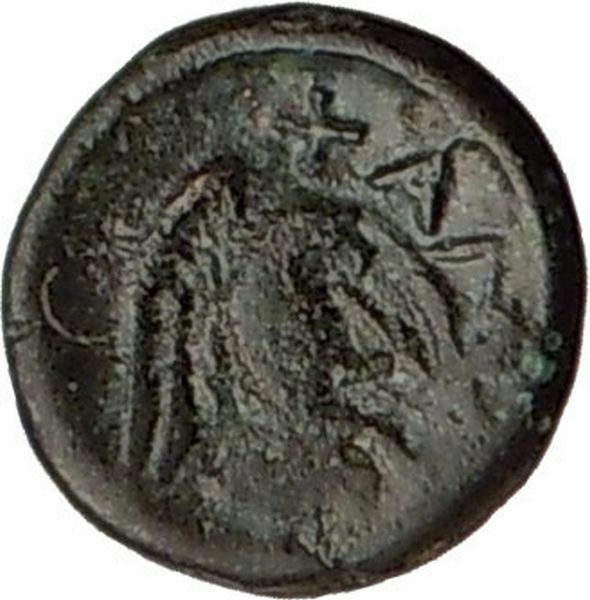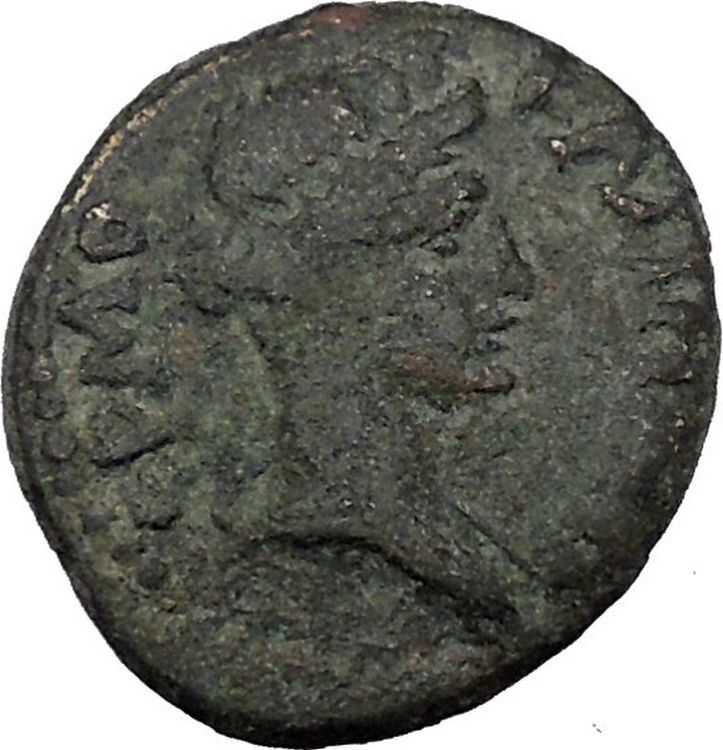|
Greek city of
Sardes in
Lydia
Bronze 12mm (3.73 grams) Struck circa 133 B.C. – 14 A.D.
Reference: SNG Cop. 469; Johnston 228-30 var. (monograms); BMC 45-6 var. (same);
SNG Copenhagen –
Laureate head of young Hercules right, wearing lion’s skin.
ΣΑΡΔΙ / ΑΝΩΝ either side of
kantharos.
The ancient capital of the Lydian Kings, Sardeis lay under a
fortified hill in the Hermos valley, at the important road junction. In the
pre-Alexandrian age it was the center of the principal Persian satrapy, ad in
all probability the mint-place of much of the Persian imperial coinage of darics
and sigloi. In 189 B.C. it came under the rule of the Attalids of Pergamon, and
fifty-six years later it passes to the Romans.
You are bidding on the exact item pictured,
provided with a Certificate of Authenticity and Lifetime Guarantee of
Authenticity.
Hercules is the Roman name for the Greek
divine
hero Heracles
, who was the son of
Zeus (Roman equivalent
Jupiter
) and the mortal
Alcmene
. In
classical mythology
, Hercules is famous for his
strength and for his numerous far-ranging adventures.

The Romans adapted the Greek hero’s iconography and myths for their
literature and art under the name Hercules. In later
Western art
and literature and in
popular culture
, Hercules is more
commonly used than Heracles as the name of the hero. Hercules was a
multifaceted figure with contradictory characteristics, which enabled later
artists and writers to pick and choose how to represent him. This article
provides an introduction to representations of Hercules in the
later tradition
.
Labours
Hercules is known for his many adventures, which took him to the far reaches
of the
Greco-Roman world
. One cycle of these
adventures became
canonical
as the “Twelve Labours,” but the list
has variations. One traditional order of the labours is found in the
Bibliotheca
as follows:
- Slay the
Nemean Lion
.
- Slay the nine-headed
Lernaean Hydra
.
- Capture the
Golden Hind of Artemis
.
- Capture the
Erymanthian Boar
.
- Clean the Augean
stables in a single day.
- Slay the
Stymphalian Birds
.
- Capture the
Cretan Bull
.
- Steal the
Mares of Diomedes
.
- Obtain the girdle of
Hippolyta
, Queen of the
Amazons
.
- Obtain the cattle of the monster
Geryon
.
- Steal the apples of the
Hesperides
.
- Capture and bring back
Cerberus
.
The Latin
name Hercules was borrowed through
Etruscan
, where it is represented variously as
Heracle
, Hercle, and other forms. Hercules was
a favorite subject for
Etruscan art
, and appears often on
bronze mirrors
. The Etruscan form Herceler
derives from the Greek Heracles via
syncope
. A mild oath invoking Hercules (Hercule!
or Mehercle!) was a common
interjection
in
Classical Latin
.

Baby Hercules strangling a
snake
sent to
kill him in his
cradle
(Roman marble, 2nd century CE)
Hercules had a number of
myths
that were distinctly Roman. One of these
is Hercules’ defeat of
Cacus
, who was terrorizing the countryside of
Rome. The hero was associated with the
Aventine Hill
through his son
Aventinus
.
Mark Antony
considered him a personal patron
god, as did the emperor
Commodus
. Hercules received various forms of
religious veneration
, including as a
deity concerned with children and childbirth
,
in part because of myths about his precocious infancy, and in part because he
fathered countless children. Roman brides wore a special belt tied with the “knot
of Hercules“, which was supposed to be hard to untie.[4]
The comic playwright
Plautus
presents the myth of Hercules’
conception as a sex comedy in his play
Amphitryon
;
Seneca
wrote the tragedy Hercules Furens
about his bout with madness. During the
Roman Imperial era
, Hercules was worshipped
locally from Hispania
through
Gaul.
Medieval mythography
After the Roman Empire became
Christianized
, mythological narratives were
often reinterpreted as
allegory
, influenced by the philosophy of
late antiquity
. In the 4th century,
Servius
had described Hercules’ return from the
underworld as representing his ability to overcome earthly desires and vices, or
the earth itself as a consumer of bodies. In medieval mythography, Hercules was
one of the heroes seen as a strong role model who demonstrated both valor and
wisdom, with the monsters he battles as moral obstacles. One
glossator
noted that when
Hercules became a constellation
, he showed that
strength was necessary to gain entrance to Heaven.
Medieval mythography was written almost entirely in Latin, and original Greek
texts were little used as sources for Hercules’ myths.
Renaissance
mythography
The Renaissance
and the invention of the
printing press
brought a renewed interest in
and publication of Greek literature. Renaissance mythography drew more
extensively on the Greek tradition of Heracles, typically under the Romanized
name Hercules, or the alternate name
Alcides
. In a chapter of his book
Mythologiae (1567), the influential mythographer
Natale Conti
collected and summarized an
extensive range of myths concerning the birth, adventures, and death of the hero
under his Roman name Hercules. Conti begins his lengthy chapter on Hercules with
an overview description that continues the moralizing impulse of the Middle
Ages:
Hercules, who subdued and destroyed monsters, bandits, and criminals, was
justly famous and renowned for his great courage. His great and glorious
reputation was worldwide, and so firmly entrenched that he’ll always be
remembered. In fact the ancients honored him with his own temples, altars,
ceremonies, and priests. But it was his wisdom and great soul that earned
those honors; noble blood, physical strength, and political power just
aren’t good enough.
_with_Female_Head_-_Walters_482763_-_View_A.jpg/260px-Greek_-_Red-Figure_Kantharos_(Drinking_Vessel)_with_Female_Head_-_Walters_482763_-_View_A.jpg)
A
kantharos or cantharus is a type of
Greek pottery
used for drinking. In its iconic
“Type A” form, it is characterized by its deep bowl, tall pedestal foot, and
pair of high-swung handles which extend above the lip of the pot. The Greek
words kotylos (κότῦλος, masculine) and kotyle (κοτύλη, feminine)
are other ancient names for this same shape.
The kantharos is a cup used to hold
wine, possibly for drinking or for
ritual
use or
offerings
. The kantharos seems to be an
attribute of
Dionysos
, the god of wine, who was associated
with
vegetation
and
fertility
.
It may not be a banquet-cup, but rather a vessel used in pagan cult as a
symbol of
rebirth or resurrection
, the
immortality
Sardiss or Sardes was an ancient city at the location of modern
Sart (Sartmahmut before 19 October 2005) in
Turkey
‘s
Manisa Province
. Sardis was the capital of the ancient kingdom of
Lydia
,[1]
one of the important cities of the
Persian Empire
, the seat of a
proconsul
under the
Roman
Empire
, and the metropolis of the province Lydia in later Roman and
Byzantine
times. As one of the
Seven churches of Asia
, it was addressed by the author John of the
Book of Revelation
in the Holy Bible in terms which seem to imply that its
population was notoriously soft and fainthearted. Its importance was due, first
to its military strength, secondly to its situation on an important highway
leading from the interior to the
Aegean
coast, and thirdly to its commanding the wide and fertile plain of the
Hermus
.
Geography
Map of Sardis and Other Cities within the Lydian Empire
Sardis was situated in the middle of
Hermus
valley, at the foot of
Mount Tmolus
, a steep and lofty spur which formed the citadel. It was about
4 kilometres (2.5 mi) south of the Hermus. Today, the site is located by the
present day village of Sart, near
Salihli
in
the Manisa province of Turkey, close to the
Ankara
–
İzmir
highway
(approximately 72 kilometres (45 mi) from
İzmir
). The part
of remains including the bath-gymnasium complex, synagogue and Byzantine shops
is open to visitors year-round.
History
Remains of the
Byzantine
shops in Sardis
The earliest reference to Sardis is in the
The
Persians
of
Aeschylus
(472 BC); in the Iliad
, the name Hyde seems to be given to the city of the
Maeonian
(i.e.
Lydian
)
chiefs, and in later times Hyde was said to be the older name of Sardis, or the
name of its citadel
. It is, however, more probable that Sardis was not the original
capital of the Maeonians, but that it became so amid the changes which produced
the powerful
Lydian empire
of the 8th century BC.
The city was captured by the
Cimmerians
in the 7th century BC, by the
Persians
in the 6th, by the
Athenians
in
the 5th, and by
Antiochus III the Great
at the end of the 3rd century BC. In the Persian
era, Sardis was conquered by
Cyrus the Great
and formed the end station for the Persian
Royal Road
which began in
Persepolis
,
capital of
Persia
. During the
Ionian Revolt
, the
Athenians
burnt down the city. Sardis remained under Persian domination
until it surrendered to
Alexander the Great
in 334 BC.
The early Lydian kingdom was very advanced in the industrial arts and Sardis
was the chief seat of its manufactures. The most important of these trades was
the manufacture and dyeing of delicate woolen stuffs and carpets. The stream
Pactolus
which flowed through the market-place “carried golden sands” in early antiquity,
which was in reality gold dust out of
Mount Tmolus
. It was during the reign of King
Croesus
that
the
metallurgists
of Sardis discovered the secret of separating
gold from
silver
, thereby
producing both metals of a purity never known before. This was an economic
revolution, for while gold nuggets panned or mined were used as currency, their
purity was always suspect and a hindrance to trade. Such nuggets or coinage were
naturally occurring alloys of gold and silver known as
electrum
and one could never know how much of it was gold and how much was silver. Sardis
now could mint nearly pure silver and gold coins, the value of which could
be—and was—trusted throughout the known world. This revolution made Sardis rich
and Croesus
‘
name synonymous with wealth itself. For this reason, Sardis is famed in history
as the place where modern
currency
was invented.
Disaster came to the great city under the reign of the emperor
Tiberius
,
when in
AD 17, Sardis was destroyed by an earthquake
, but it was rebuilt. It was one
of the great cities of western
Asia Minor
until the later
Byzantine
period.
Later, trade and the organization of commerce continued to be sources of
great wealth. After
Constantinople
became the capital of the East, a new road system grew up
connecting the provinces with the capital. Sardis then lay rather apart from the
great lines of communication and lost some of its importance. It still, however,
retained its titular supremacy and continued to be the seat of the
metropolitan bishop
of the province of Lydia, formed in AD 295. It was
enumerated as third, after
Ephesus
and
Smyrna
, in the
list of cities of the Thracesion
thema
given by
Constantine Porphyrogenitus
in the 10th century. However, over the next four
centuries it was in the shadow of the provinces of Magnesia-upon-Sipylum and
Philadelphia, which retained their importance in the region.
After 1071 the Hermus valley began to suffer from the inroads of the
Seljuk Turks
but the Byzantine general
John Doukas
reconquered the city in 1097, the successes of the general
Philokales in 1118 relieved the district from later Turkish pressure and the
ability of the Comneni
dynasty together with the gradual decay of the
Seljuk Sultanate of Rum
meant that it remained under Byzantine dominion.
When
Constantinople
was taken by the
Venetians
and Franks
in 1204 Sardis came under the rule of the Byzantine
Empire of Nicea
. However once the Byzantines retook Constantinople in 1261,
Sardis with the entire
Asia Minor
was neglected and the region eventually fell under the control of
Ghazi (Ghazw)
emirs, the
Cayster
valleys and a fort on the citadel of Sardis was handed over to them
by treaty in 1306. The city continued its decline until its capture (and
probable destruction) by the
Mongol
warlord Timur
in 1402.
Archaeological
expeditions
By the 19th century, Sardis was in ruins, showing construction chiefly of the
Roman period. Early excavators included the British explorer
George Dennis
, who uncovered an enormous marble head of
Faustina the Elder
, wife of the Roman Emperor
Antoninus Pius
. Found in the precinct of the Temple of
Artemis
, it
probably formed part of a pair of colossal statues devoted to the Imperial
couple. The 1.76 metre high head is now kept at the
British Museum
.[4]
The first large scale archaeological expedition in Sardis was directed by a
Princeton University
team led by Howard Crosby Butler between years
1910–1914, unearthing a temple to
Artemis
, and
more than a thousand Lydian tombs. The excavation campaign was halted by
World War
I
, followed by the
Turkish War of Independence
, though it briefly resumed in 1922. Some
surviving artifacts from the Butler excavation were added to the collection of
the
Metropolitan Museum of Art
in
New York
.
A new expedition known as the Archaeological Exploration of Sardis was
founded in 1958 by G.M.A. Hanfmann, professor in the Dept. of Fine Arts at
Harvard University
, and by Henry Detweiler, dean of the Architecture School
at
Cornell University
. Hanfmann excavated widely in the city and the region,
excavating and restoring the major Roman bath-gymnasium complex, the synagogue,
late Roman houses and shops, a Lydian industrial area for processing electrum
into pure gold and silver, Lydian occupation areas, and tumulus tombs at Bin
Tepe. From 1976 until 2007, the excavation was directed by Crawford H.
Greenewalt, jr., professor in the Department of Classics at the
University of California, Berkeley
. Since 2008, the excavation has been
under the directorship of Nicholas Cahill, professor at the
University of Wisconsin–Madison
. The laws governing archaeological
expeditions in Turkey ensure that all archaeological artifacts remain in Turkey.
Some of the important finds from the site of Sardis are housed in the
Archaeological Museum of Manisa
, including Late Roman mosaics and sculpture,
a helmet from the mid-6th century BC, and pottery from various periods.
Sardis synagogue
A recent view of the
Sardis Synagogue
Since 1958, both
Harvard
and
Cornell Universities
have sponsored annual archeological expeditions to
Sardis. These excavations unearthed perhaps the most impressive synagogue in the
western diaspora yet discovered from antiquity, yielding over eighty Greek and
seven Hebrew inscriptions as well as numerous mosaic floors. (For evidence in
the east, see
Dura Europos
in Syria
.) The discovery of the Sardis synagogue has reversed previous
assumptions about Judaism in the later Roman empire. Along with the discovery of
the godfearers
/theosebeis inscription from
Aphrodisias
, it provides indisputable evidence for the continued presence of
Jewish communities in Asia Minor and their integration into general Roman life
at a time when many scholars previously assumed that Christianity had eclipsed
Judaism.
The synagogue was a section of a large bath-gymnasium complex, that was in
use for about 450 – 500 years. In the beginning, middle of the 2nd century AD,
the rooms the synagogue is situated in were used as changing rooms or resting
rooms.
Sardis and the Hebrew
Sepharad
may have been one and the same.
|







_with_Female_Head_-_Walters_482763_-_View_A.jpg/260px-Greek_-_Red-Figure_Kantharos_(Drinking_Vessel)_with_Female_Head_-_Walters_482763_-_View_A.jpg)






